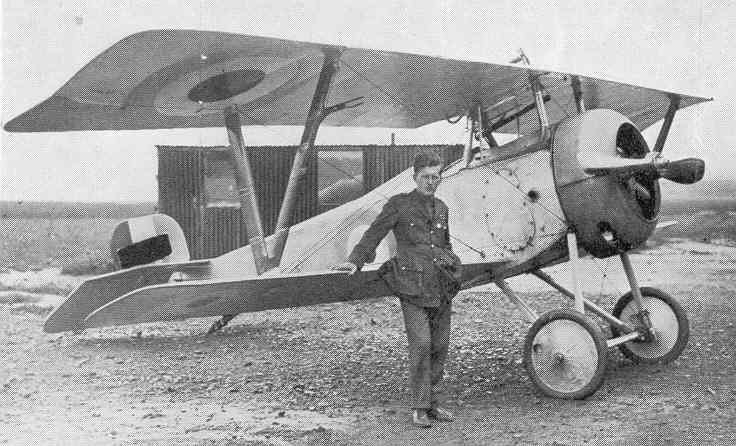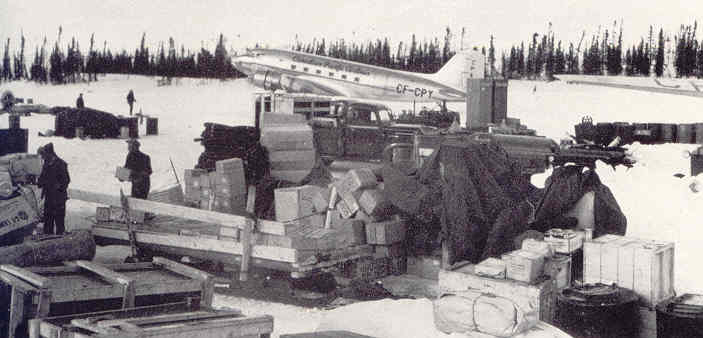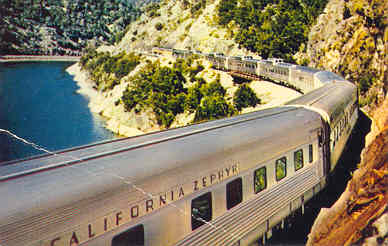The Canadian transportation situation after
World War II
Is someone else going to eat the CPR's lunch?
CPR "The Canadian"
By 1946, the Canadian railways had "owned" most of the long distance
passenger business for 60 years.
In total, the Canadian railway network included about 43,000 miles
of track. Railways remained the most efficient way to move large numbers
of people around a continent-sized country at reasonable prices. Personnel
returning from World War II were keeping the railways busy during this
period.
By this time, Canada had 125,000 miles of surfaced roads and
over three times that in gravel and dirt roads. Even with wartime manufacturing
restrictions on the production of new private automobiles, 11.5 million
Canadians were driving 1.5 million cars on those half-million miles
of Canadian roads. The completion of the the Trans-Canada Highway was
over a decade away. In practical terms, you still couldn't get there from
here.
However, it was another mode of passenger transportation that
was in the process of eroding the railways' control over long distance
travel.
In 1946, both the government-owned CNR and the exchange-traded
CPR had their air transportation components : Trans-Canada Air Lines
and Canadian Pacific Air Lines respectively. To quote an executive
of the CPR regarding the railway boardroom attitude toward the airline
in the 1940s and 1950s: " ... we expected to keep the railway operating
profitably and were skeptical of the airline ever contributing much
to the parent company's profits."
In an earlier time, those who built Canada's railways were
daring risk takers ... often with the Government's deep pockets
backing up the enterprise. A new railway was good for local property
values, good for business, and generally good for the country. In some
cases, the risk worked out poorly, and a Government separated the entrepreneurs
from their dreams - generally when the financial situation or political
"optics" were not helpful to the Government's staying in power.
With the old "building in the wilderness from scratch" challenges
long since dealt with, the shiny-shoed boardroom class which had since
evolved on the railways was about to meet the ultimate risk takers ...
The Development of Aviation in Canada, 1914-1946
Sometimes to avoid the mud and death of the World War I trenches
and often for the adventure, Canadians joined Britain's newly hatched
Royal Flying Corps. Between 1914 and 1918, using rapidly evolving technology
and combat tactics, some like Major W.A. Bishop, VC, DSO, MC ended the
war alive and as Canadian heroes.
Billy Bishop "a man incapable of fear" - according
to one American ace - and a Nieuport 17
After World War I, this spirit of innovation and risk taking
found its natural match in Canada's geography. Here was a country with
vast expanses of unmapped wilderness in which untold mineral wealth
probably lay. Certainly most of the country lay beyond economical reach
of railway technology, and the centuries-old practice of travel by canoe
and portaging was due for replacement.
First travelling in "flying canoes" (wooden-hulled flying boats)
exploration, and later the systematic aerial photography and mapping
of remote Canada, was begun by adventurous aviators. Floatplanes - ski-planes
in winter - also ferried in geologists, engineers, miners, equipment
and supplies.
They could land on water or snow - and Canada had an endless
inventory of lakes to use as runways!
- Heated hangers in which to repair winter breakdowns?
- Northern weather reports?
- Radar guidance and traffic control?
- Government provided Search and Rescue?
- No - the early bush pilots were pretty much on their own ...
flying only by basic cockpit instruments, experience, and their finely-tuned
senses. Sometimes following an "iron compass" (a railway line) helped them
reach their destinations.
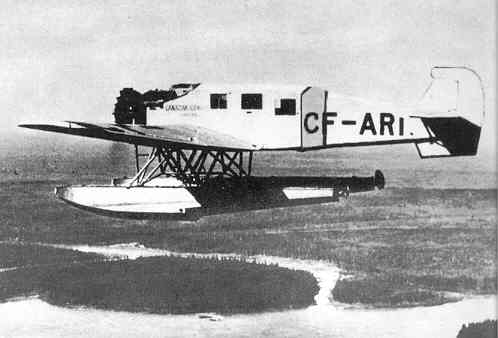 A Canadian bush plane equipped with floats.
A Canadian bush plane equipped with floats.
In 1928, surveys for a trans-Canada airway were begun - an aerial
highway between east and west. The Depression put much of the more
expensive development on hold, but unemployed workers were offered some
of the more basic preparation work.
In 1937, Transport Minister C.D. Howe said that "Canadians
were insistent in demanding the establishment of a direct Canadian
[air mail] service" - rather than having western-Canadian airmail travelling
aboard American airmail aircraft. So Trans-Canada Airlines (TCA) was born
and the systems needed to support it (air fields, passenger terminals, training
standards, navigation charts, meteorological services) were brought up
to snuff.
While the CPR and its airlines might have been part of Trans-Canada
Airlines at one point, things didn't go well : it seemed the government
was determined to have a national air carrier, with
break-even finances, working as a monopoly
. The CPR-owned airlines were allowed to operate domestically in areas
where the TCA had no interest.
By 1939, daily passenger, air mail and air express services
were being operated by TCA between Montreal, Toronto and Vancouver with
various stops along the way. Canada's involvement in World War II 1939-1945
changed priorities. Supporting the war by carrying vital priority freight,
mail and key military personnel became the new mission of TCA.
During the Second World War, Canada became "The Aerodrome of
Democracy" (thanks for that title, FDR) with the establishment of the
British Commonwealth Air Training Plan (BCATP). Vast and far beyond
the range of enemy planes, Canada was an ideal site for training aircrew.
Over 130,000 aircrew, from pilots to air gunners, graduated from the
107 schools of the BCATP.
Besides Australia, New Zealand, Britain and Canada, students also
came from the US (officially at war later in 1941) and the occupied
countries of Europe. Canada paid for 75% of the program. The Canadians
who graduated constituted about 25% of the strength of the RAF and also
formed 45 Royal Canadian Air Force squadrons overseas.
Many of the RCAF personnel were assigned to RAF Bomber Command. The
official figures were not known to them at the time, but these airmen had
little statistical chance of surviving their 30 sortie "tours" in the deadly
night skies of Europe.
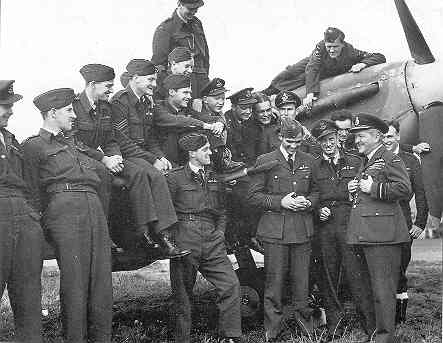 Air Marshal W.A. Bishop, Director of Recruiting, Royal Canadian
Air Force
Air Marshal W.A. Bishop, Director of Recruiting, Royal Canadian
Air Force
visiting RCAF 411 Squadron (Spitfires) in England,
1942
After all this - after the Great Depression and World War II - there
was one positive outcome ...
Canadians now had the ability to really get going on civil
aviation:
- All kinds of infrastructure used by the BCATP : airfields,
hangars, weather offices, guidance beacons.
- Ferry pilots who had repeatedly delivered new two and four-engined
Canadian-manufactured bombers across the Atlantic Ocean - travelling from
Canada; to Gander, Newfoundland; to Britain. There was no traffic control
guidance back then - a compass and "star shots" were all crews had for navigation
across the ocean.
- Bush pilots who had supported feverish wartime prospecting
for new mineral resources - including uranium.
- Experienced RCAF pilots and crews, many of whom would be discharged
and available for airline training after the war.
- Significant warplane manufacturing experience, and experience
maintaining all the BCATP trainer aircraft.
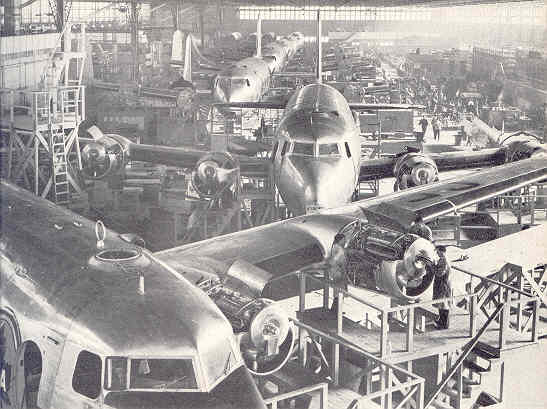 At Canadair in Toronto, TCA passenger planes are assembled
circa 1948.
At Canadair in Toronto, TCA passenger planes are assembled
circa 1948.
Note the circular hole in the cockpit roof - a "glass" dome will be
fitted here to permit celestial navigation.
TCA covered any domestic route it thought was worthwhile, as well
as trans-Atlantic, Pacific and service to the Caribbean.
Where permitted,
TCA would also fly into the US.
This is what things looked like right after World War II. You
can probably assume that many of the "other Canadian airlines" were owned
by the CPR.
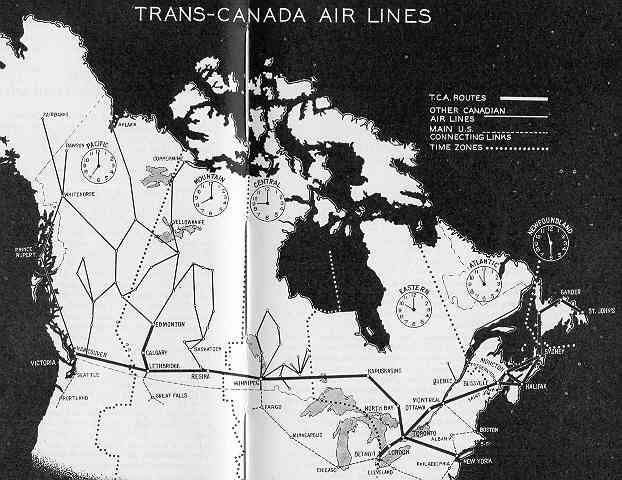 Aerial "highways" in Canada, 1946
Aerial "highways" in Canada, 1946
Canadian Pacific Airlines in the bush.
Take it easy with the dynamite, boys.
In 1946, according to the Government of Canada:
"Thousands of miles are interpreted as hours of distance;
far flung communities have been drawn close together.
TCA has brought
to Canada a new vision of unity, a new vision of the future."
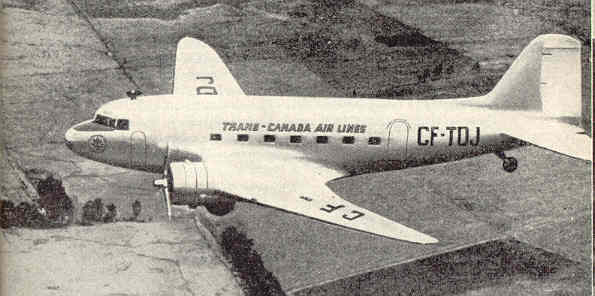
A TCA Douglas DC-3 in flight in 1946. The first prototype
had flown in 1933.
From wood, cloth and wire - to brushed, stressed-skin
aluminum carrying 14 passengers coast to coast 25 years later.
But what was happening on the rails?
Canadian Pacific Railway's "The Canadian"
(I'm giving the ending first for dramatic effect and pathos.)
Only 16 years after its birth, the final great effort by the CPR
to save its eroding long distance passenger market would be abandoned by
corporate executives, unloved, at the doorstop of the federal regulator.
And for almost a decade, the feds booted the foundling basket
containing The Canadian back to the curb - and told CP Rail
to keep the train rolling.
Canada's last great long distance passenger train was genuinely
Canadian Pacific and Canadian in many ways.
Ironically for proud Canadian nationalists, its inspiration and
principal manufacturing were American.
The Zephyrs and Shotwelding
Passenger trains in the 1920s were pulled by heavy, black, smoke-spewing
locomotives which left a layer of black dust on the window sills of the
trailing passenger cars. The windows opened because most of the cars had
no cooling systems. Air conditioned sleeping cars often used circulating
meltwater from large ice blocks and little electric fans so summer travellers
might be less uncomfortable.
The new streamlined shapes used in aircraft design were capturing
the public's imagination in the late 1920s and early 1930s. Among railroad
executives in the US, the less complacent saw the potential threats to their
passenger business from aircraft and autos ... and the potential marketing
opportunities if they played to this desire for silver, streamlined vehicles.
Railways and locomotive builders were working
on using diesel-electric technology in locomotives.
The Budd Company of Philadelphia had patented a process for welding
stainless steel.
An innovative result was the Pioneer Zephyr
(ZEF fer).
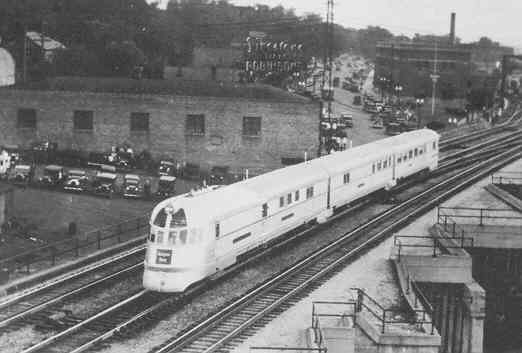
In May 1938, this Zephyr trainset is averaging
78 mph on a special speed trial run between Denver and Chicago - 1015
miles.
Shotwelding - some details
- Stainless steel passenger car exteriors require very little
maintenance and no periodic painting.
- Conventional welding ruins the anti-corrosion properties of stainless
steel.
- Shotwelding was patented in the early 1930s.
- In shotwelding : two pieces of stainless steel were joined
into one uniform piece of stainless steel by attaching two electrodes
on opposite sides of the desired weld location. Then, a precisely calculated
amount of current was run for a precisely calculated instant of time between
the electrodes through the spots to be joined.
- Shotwelding produced a stronger structure than rivetting, and
made the attractive uniform silver skins of modern passenger equipment
possible.
The Pioneer Zephyr - some details
- Railroad : Chicago, Burlington and Quincy - "The Burlington
Route"
- Top speed : 110 mph
- Passenger capacity : 72
- Motive power : 600 hp diesel-electric powering two axles
- This was an "articulated" trainset which shared
wheelsets between the cars to save weight. Railways
usually overbuilt stuff and the Zephyr was unusually light and fast. The
Zephyr cars were coupled over those shared wheelsets and
the trainset could not be made longer or shorter to meet traffic demand
like other railway equipment.
- It was not designed to be compatible with the huge quantity
of traditional rolling stock available at the time.
- The locomotive engineer was in a very exposed position
if there was a level crossing collision with a truck. Fortunately there
is no record of an engineer ever complaining after such a collision.
- It probably rode like a little red wagon on a slab sidewalk,
but it was shiny and fast and captured the imagination of the Depression-era
public.
- To some extent it set the standard for the external appearance
of modern passenger equipment.
"Zephyrs" proliferate
Luxurious, standard coupling, smooth riding, electrically air-conditioned
Budd-built passenger cars were used on the train named the California
Zephyr, operating between Chicago and Oakland (2500 miles) beginning
in 1949. Special observation "dome cars" were included in this train consist
and it travelled via several different railroads on its route. Silver
streamlined "zephyr equipment" was common and quite famous in the late
1940s, and the 1949 California Zephyr is seen by many as
the high point of the zephyr era.
The California Zephyr in California's Feather
River Canyon.
Notice there are 4 "Vista-Dome" cars behind the Western Pacific locomotives.
On its westbound trip, the train travelled mainly on the lines of the Burlington;
Rio Grande; and Western Pacific -
with the eastbound California Zephyr covering these roads in reverse order.
The CNR and CPR had nothing like it.
The CPR's gamble
Early in 1953, the Canadian Pacific Railway did a "me too", called
up Budd in Philadelphia and ordered 173 stainless steel cars for a new
train named "The Canadian". (The first choice for a name
was "The Royal Canadian" but perhaps there was malice at the palace about
the idea. It would have been a violation of protocol to use such a name without
young Queen Elizabeth II's permission.) The CPR also added to their roster
of diesel locomotives to get the project rolling.
At Stoney Creek Bridge, here is a typical CPR publicity photo of
an eastbound train of the new zephyr, I mean Canadian
, equipment with a dome car on the tailend.
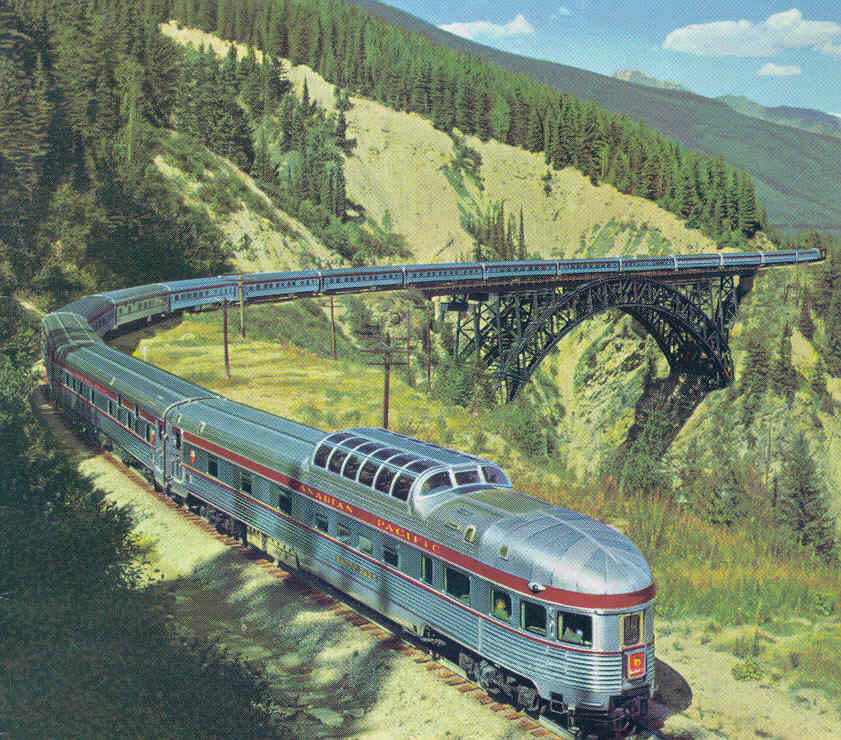
Near the headend, at the far end of the bridge, are three old sleeping
cars with ordinary painted steel sides and old-style clerestory roofs -
but they are dressed up with the special Budd stainless steel plating.
They are doing their best to adapt and be "modern".
As a "North American Zephyr", this train was unique
in the sense that it was operated "across the continent" - Montreal to Vancouver
- by and on one single railway. The CNR operated trains on the same transcontinental
scale, but they didn't buy brand new equipment in the 1950s to create a completely
"new concept" as the CPR did.
Railway infrastructure is capital intensive - a physical
"road" must be built and carefully maintained forever.
Particularly during the two world wars, aviation technology developed
very quickly.
Canadians became proud of the bush pilots, the RCAF, and Trans-Canada
Airlines
as part of their modern national identity.
It was easy for the federal government to throw its full support behind
aviation in Canada.
It was politically attractive to support magically fast travel
on modern equipment.
In addition, those symbolic contrails in the sky from sea to sea
and far into the arctic
would be much cheaper to finance than the steel rails had ever
been.
In the 1950s, the diehard railroaders of the CPR gambled,
giving transcontinental passenger rail service
the brilliant sunset they felt it deserved.
Back to sitemap
